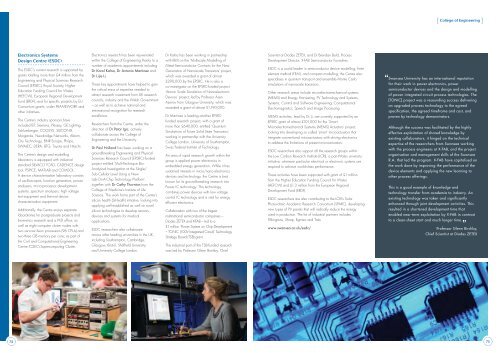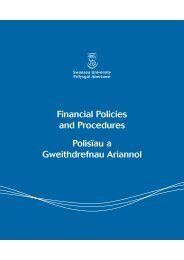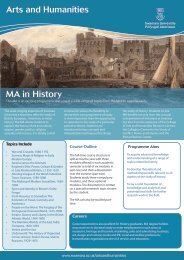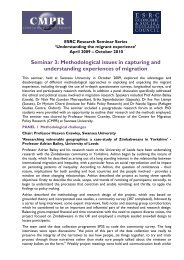College of Engineering - Swansea University
College of Engineering - Swansea University
College of Engineering - Swansea University
Create successful ePaper yourself
Turn your PDF publications into a flip-book with our unique Google optimized e-Paper software.
]<br />
<strong>College</strong> <strong>of</strong> <strong>Engineering</strong> ]<br />
Electronics Systems<br />
Design Centre (ESDC)<br />
The ESDC’s current research is supported by<br />
grants totalling more than £4 million from the<br />
<strong>Engineering</strong> and Physical Sciences Research<br />
Council (EPSRC), Royal Society, Higher<br />
Education Funding Council for Wales<br />
(HEFCW), European Regional Development<br />
Fund (ERDF), and for specific projects by EU<br />
Consortium grants, under FRAMEWORK and<br />
other initiatives.<br />
The Centre’s industry sponsors have<br />
included BT, Siemens, Plessey, GE Lighting,<br />
Schlumberger, COGSYS, SILICONIX,<br />
Morganite, Newbridge Networks, Alstom,<br />
City Technology, BNR Europe, Philips,<br />
SWALEC, DERA, BTG, Toyota and Hitachi.<br />
The Centre’s design and modelling<br />
laboratory is equipped with industrial<br />
standard SILVACO TCAD, CADENCE design<br />
tool, PSPICE, MATLAB and COMSOL.<br />
A device characterisation laboratory consists<br />
<strong>of</strong> oscilloscopes, function generators, power<br />
analysers, micro-processor development<br />
systems, spectrum analysers, high voltage<br />
test equipment and thermal device<br />
characterisation equipment.<br />
Additionally, the Centre enjoys separate<br />
laboratories for postgraduate projects and<br />
biometrics research and a PhD <strong>of</strong>fice, as<br />
well as eight computer cluster nodes with<br />
two six-core Xeon processors (96 CPUs) and<br />
two-three GB memory per core, as part <strong>of</strong><br />
the Civil and Computational <strong>Engineering</strong><br />
Centre (C2EC) Supercomputing Cluster.<br />
Electronics research has been rejuvenated<br />
within the <strong>College</strong> <strong>of</strong> <strong>Engineering</strong> thanks to a<br />
number <strong>of</strong> academic appointments including<br />
Dr Karol Kalna, Dr Antonio Martinez and<br />
Dr Lijie Li.<br />
These key appointments have helped to gain<br />
the critical mass <strong>of</strong> expertise needed to<br />
attract research investment from UK research<br />
councils, industry and the Welsh Government<br />
– as well as to achieve national and<br />
international recognition for research<br />
excellence.<br />
Researchers from the Centre, under the<br />
direction <strong>of</strong> Dr Petar Igic, actively<br />
collaborate across the <strong>College</strong> <strong>of</strong><br />
<strong>Engineering</strong> and the <strong>University</strong>.<br />
Dr Paul Holland has been working on a<br />
groundbreaking <strong>Engineering</strong> and Physical<br />
Sciences Research Council (EPSRC) funded<br />
project entitled ‘Multi-Technique Bio-<br />
Analytical Investigation at the Single/<br />
Sub-Cellular Level Using a New<br />
Lab-On-A-Chip Technology Platform’,<br />
together with Dr Cathy Thornton from the<br />
<strong>College</strong> <strong>of</strong> Medicine’s Institute <strong>of</strong> Life<br />
Science. This work forms part <strong>of</strong> the Centre’s<br />
silicon health (SiHealth) initiative, looking into<br />
applying well-established as well as novel<br />
silicon technologies to develop sensors,<br />
devices and systems for medical<br />
applications.<br />
ESDC researchers also collaborate<br />
across other leading universities in the UK,<br />
including Southampton, Cambridge,<br />
Glasgow, Bristol, Sheffield <strong>University</strong>,<br />
and <strong>University</strong> <strong>College</strong> London.<br />
Dr Kalna has been working in partnership<br />
with IBM on the ‘Multiscale Modelling <strong>of</strong><br />
Metal-Semiconductor Contacts for the Next<br />
Generation <strong>of</strong> Nanoscale Transistors’ project,<br />
which was awarded a grant <strong>of</strong> almost<br />
£290,000 by the EPSRC. He is also a<br />
co-investigator on the EPSRC-funded project<br />
‘Atomic Scale Simulation <strong>of</strong> Nanoelectronic<br />
Devices’ project, led by Pr<strong>of</strong>essor Asen<br />
Asenov from Glasgow <strong>University</strong>, which was<br />
awarded a grant <strong>of</strong> almost £1,190,000.<br />
Dr Martinez is leading another EPSRCfunded<br />
research project, with a grant <strong>of</strong><br />
more than £640,000, entitled ‘Quantum<br />
Simulations <strong>of</strong> Future Solid State Transistors’,<br />
working in partnership with the <strong>University</strong><br />
<strong>College</strong> London, <strong>University</strong> <strong>of</strong> Southampton,<br />
Swiss Federal Institute <strong>of</strong> Technology.<br />
An area <strong>of</strong> rapid research growth within the<br />
group is applied power electronics in<br />
embedded energy generation. While it has<br />
sustained interests in micro/nano electronics<br />
devices and technology, the Centre is best<br />
known for its ground-breaking research into<br />
Power IC technology. This technology<br />
combines power devices with low voltage<br />
control IC technology and is vital for energy<br />
efficient electronics.<br />
Collaboration with two <strong>of</strong> the largest<br />
multinational semiconductor companies –<br />
Diodes ZETEX and X-FAB – led to a<br />
£1 million ‘Power System on Chip Development<br />
– TONIC (100V Integrated Circuit)’ Technology<br />
Strategy Board (TSB) grant.<br />
The industrial part <strong>of</strong> the TSB-funded research<br />
was led by Pr<strong>of</strong>essor Glenn Birchby, Chief<br />
Scientist at Diodes ZETEX, and Dr Brendan Bold, Process<br />
Development Director, X-FAB Semiconductor Foundries.<br />
ESDC is a world leader in semiconductor device modelling, finite<br />
element method (FEM), and compact modelling, the Centre also<br />
specialises in quantum transport and ensemble Monte Carlo<br />
simulations <strong>of</strong> nanoscale transistors.<br />
Other research areas include microelectromechanical systems<br />
(MEMS) and Energy Harvesting, PV Technology and Systems,<br />
Systems, Control and S<strong>of</strong>tware <strong>Engineering</strong>, Computational<br />
Electromagnetics, Speech and Image Processing.<br />
MEMS activities, lead by Dr Li, are currently supported by an<br />
EPSRC grant <strong>of</strong> almost £101,000 for the ‘Smart<br />
Microelectromechanical Systems (MEMS) Actuators’ project,<br />
looking into developing so called ‘smart’ microactuators that<br />
integrate conventional microactuators with driving electronics<br />
to address the limitations <strong>of</strong> present microactuators.<br />
ESDC researchers also support all the research groups within<br />
the Low Carbon Research Institute (LCRI), a pan-Wales university<br />
initiative, wherever particular electrical or electronic systems are<br />
required to achieve world-class performance.<br />
These activities have been supported with grant <strong>of</strong> £1 million<br />
from the Higher Education Funding Council for Wales<br />
(HEFCW) and £1.3 million from the European Regional<br />
Development Fund (ERDF).<br />
ESDC researchers are also contributing to the LCRI’s Solar<br />
Photovoltaic Academic Research Consortium (SPARC), developing<br />
new types <strong>of</strong> PV panels that will radically reduce the energy<br />
used in production. The list <strong>of</strong> industrial partners includes<br />
Pilkingtons, Sharp, Egnitec and Tata.<br />
www.swansea.ac.uk/esdc/<br />
“<strong>Swansea</strong> <strong>University</strong> has an international reputation<br />
for their work in power electronics, power<br />
semiconductor devices and the design and modelling<br />
<strong>of</strong> power integrated circuit process technologies. The<br />
[TONIC] project was a resounding success delivering<br />
an upgraded process technology to the agreed<br />
specification, the agreed timeframe and cost, and<br />
proven by technology demonstrators.<br />
Although the success was facilitated by the highly<br />
effective exploitation <strong>of</strong> shared knowledge by<br />
existing collaborators, it hinged on the technical<br />
expertise <strong>of</strong> the researchers from <strong>Swansea</strong> working<br />
with the process engineers at X-FAB, and the project<br />
organisation and management skills <strong>of</strong> the <strong>Swansea</strong><br />
R.A. that led the program. X-FAB have capitalised on<br />
the work done by improving the performance <strong>of</strong> the<br />
device elements and applying the new learning to<br />
other process <strong>of</strong>ferings.<br />
This is a good example <strong>of</strong> knowledge and<br />
technology transfer from academia to industry. An<br />
existing technology was taken and significantly<br />
enhanced through joint development activities. This<br />
resulted in a shortened development time that<br />
enabled near-term exploitation by X-FAB in contrast<br />
to a clean-sheet start and much longer time.<br />
”<br />
Pr<strong>of</strong>essor Glenn Birchby,<br />
Chief Scientist at Diodes ZETEX<br />
74<br />
75

















